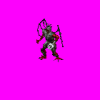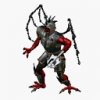So far, in game testing... here is the most current.
For Epic Games (scenario barbs may differ), barbarians are set as the Boar and the Rogue.
The Boar has slightly better stats to most Level 1 units.
The Rogue has a very deadly attack, but low defense. This is the least of one's worries early in the game, since the Rogue is invisible and has hidden identity.
There are ways to counter these threats, but careful planning is the best way to avoid getting overrun by barbs. Scouts may be able to detect invisible units, but if they are put in this way, they will be limited.
Since most units will be auto-produced by buildings, except for low-level units (level 1 and 2), this became somewhat of a problem in Epic games for a couple reasons. First, sometimes the AI has problems acquiring the correct resources needed for certain auto-production buildings (low level structures will likely be changed to omit these requirements for AI's sake). But when AI does have the resources, it does build the buildings with no problem. Level 1 unit prices (which may seem high overall compared to 10 shields for a basic warrior unit) work well for 2 reasons, one must be careful with their units in the early game, and it is a big incentive to build an auto-production building. Level 2 units which are more expensive can be built by the player/AI right now, but in the Epic Game this causes problems, because AI tends to build these instead of of anything else (and they cost a bit more than level 1). I will look to find a work-around for this though.
All-in-all, for battle, if you have the most powerful empire in the world, it gives good advantage, but with the way it works, not necessarily an end-of-game scenario. Having more cities means you can possibly spit out more lower level creatures than other civs, which are useful, but auto-production creates somewhat of a more level playing field. And depending on what civ's are near you, you really have to think about how you are going to fight your battles (all civ's and units have dramatically different stats, in other words there are 14 UU's for every civ). To win, playing to your civ's strengths will often make it much easier than battling against them.
Take the Level 1 Gremlin and Gnoll for instance:
The Gremlin, has 3 Att, 3 Def (some of the lowest stats of the game), yet costs only 15 shields.
The Gnoll has a large stat advantage! 3 Att, 5 Def, yet costs almost twice as much.
So while the Fortress Gnoll (which is great defensively) has better protection early in the game, they may struggle pumping out units in the early game.
Whereas the Tower Gremlin (the 2nd weakest unit in the game) has low stats, they are one of the cheapest, and can be pumped out in tremendous quantities, thus making their sheer numbers difficult to overcome.
After test playing a game, it is not easy just wiping other civ's off the face of the map at any point. Although tweaking will continue to take place, it makes things interesting and gives combat a bit of a different feel. For one, when you have some high level units available, it usually is a good idea to make sure they win when they attack since they are not available in near the quantity of lower level units. Losing these units can sometimes turn the tide of a war (as I found out in my test game, with the tide turned against myself).
For those not familiar with HoMM3, the civilopedia will be full of information on all aspects to make it as understandable as possible, and I'll probably include lore as well (with Roland Ironfists help

).
Finally, on Technology Research, you have Mage Guilds which provide research increase, and are available at the start of the game (but have prerequisites that must be met in order to build them). This is necessary, because there are no limits on research time for techs. If you do not ever build Mage Guilds, your research will fall way behind of others. Most tech's can be traded, but not all of them can (powerful techs cannot).
So in the beginning of a game, you may see the first tech is going to take 100 turns, but it is only because you have 1 city... after the 3rd city is built, it drops drastically down to 30 turns e.g.
Tom

 <-- Can't stop posting this exact message
<-- Can't stop posting this exact message

 ) If the gameplay will do the same ? I can not know about this - without a test play.
) If the gameplay will do the same ? I can not know about this - without a test play.
 You (and Vuldacon) are proving that a good Modder has to have good graphical skills too. For that reason I`m pretty limited in my own works.
You (and Vuldacon) are proving that a good Modder has to have good graphical skills too. For that reason I`m pretty limited in my own works.

 (I was going to put Like the sands of an hourglass but decided against it)
(I was going to put Like the sands of an hourglass but decided against it)







 ).
). ), Attack, Run, Fortify, Victory. There may also possibly be a 2nd Attack.
), Attack, Run, Fortify, Victory. There may also possibly be a 2nd Attack.


